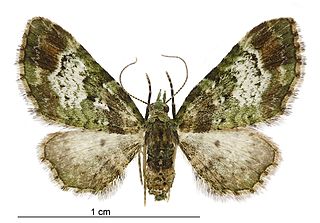
The surfbird is a small stocky wader in the family Scolopacidae. It was once considered to be allied to the turnstones, and placed in the monotypic genus Aphriza, but is now placed in the genus Calidris.

Hyles euphorbiae, the spurge hawk-moth, is a European moth of the family Sphingidae. This hawk moth is used as an agent of biological pest control against the noxious weed leafy spurge, but usually only in conjunction with other agents. The larvae consume the leaves and bracts of the plant. The species was first described by Carl Linnaeus in his 1758 10th edition of Systema Naturae.
The Field Elm cultivar Ulmus minor 'Virgata' (:'twiggy') was first described, as Ulmus campestris virgata, by Pepin in Revue Horticole (1865) from a stand of some thirty trees beside a monastery at Grand-Puits near Nangis, Seine-et-Marne, said to have been planted by the friars in 1789 and propagated in 1835 by Cochet's nursery at Grisy-Suisnes. Pepin noted that in France 'Virgata' was sometimes confused with another, less vigorous elm cultivated as 'Orme pyramidal'.

Larentiinae is a subfamily of moths containing roughly 5,800 species that occur mostly in the temperate regions of the world. They are generally considered a subfamily of the geometer moth family (Geometridae) and are divided into a few large or good-sized tribes, and numerous very small or even monotypic ones which might not always be valid. Well-known members are the "pug moths" of the Eupitheciini and the "carpets", mainly of the Cidariini and Xanthorhoini. The subfamily was described by Philogène Auguste Joseph Duponchel in 1845.

Arctostaphylos virgata is a species of manzanita known by the common names Bolinas manzanita and Marin manzanita.

Pollanisus apicalis is a moth of the family Zygaenidae. It is found in the eastern part of Australia.

Hyposmocoma virgata is a species of moth of the family Cosmopterigidae. It was first described by Lord Walsingham in 1907. It is endemic to the Hawaiian islands of Molokai and Maui.

Cataclysmiini is a tribe of geometer moths in subfamily Larentiinae.

Monocerotesa virgata is a moth in the family Geometridae first described by Wileman in 1912. It can be found in Taiwan.
The Mamfe shrew is a species of mammal in the family Soricidae. It was discovered in 1940, and can be found in Nigeria and Cameroon.
Glyphipterix virgata is a species of sedge moth in the genus Glyphipterix. It was described by Yutaka Arita and John B. Heppner in 1992. It is found in Taiwan.

Eucrostes indigenata is a moth of the family Geometridae first described by Charles Joseph Devillers in 1789. It is found in the Mediterranean region, inland up to North Macedonia and Hungary. Subspecies lanjeronica is found in southern Spain and Algeria.

Pasiphila sandycias is a moth in the family Geometridae. It is endemic to New Zealand. Adult moths of this species have been shown to pollinate Leptospermum scoparium and Olearia virgata.
Auratonota virgata is a species of moth of the family Tortricidae. It is found in Ecuador.
Auratonota tessellata is a species of moth of the family Tortricidae. It is found in Brazil.
Metarctia virgata is a moth of the subfamily Arctiinae. It was described by James John Joicey and George Talbot in 1921. It is found in the Democratic Republic of the Congo and Uganda.
Melemaea virgata is a species of geometrid moth in the family Geometridae. It is found in North America.

Euphorbia virgata, commonly known as leafy spurge, wolf's milk leafy spurge, or wolf's milk is a species of spurge native to Europe and Asia, and introduced in North America, where it is an invasive species.

Phibalapteryx is a genus of butterflies belonging to the family Geometridae.

Chrysorthenches virgata is a species of moth in the family Plutellidae. It was first described by Alfred Philpott in 1920. It is endemic to New Zealand and has been found in the North, South and Chatham Islands at altitudes ranging from sea-level up to approximately 1000 m. This species inhabits areas where its larval host plants, Libocedrus bidwillii and Cupressus macrocarpa are common. The larvae feed on the leaves of their hosts from under a silk shelter and pupate in a cocoon of thick silk covered in frass. Adult moths are on the wing from September to February as well as in April and June.
This page is based on this
Wikipedia article Text is available under the
CC BY-SA 4.0 license; additional terms may apply.
Images, videos and audio are available under their respective licenses.













